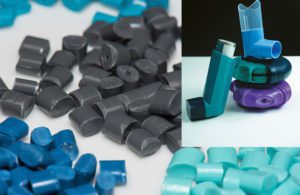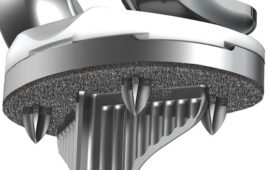
[Image courtesy of PolyOne Distribution]
Karen Heroldt, PolyOne Distribution
Choosing polymers is complicated in the high-stakes world of medical and healthcare devices. Materials can have varied tool design, molding and secondary processing requirements that can affect time to market and total production costs. Here, we explore six critical questions to ask when considering polymer options for healthcare applications and pharmaceutical packaging.
1. Will the polymer work in the design?
Material selection and product design should be parallel processes. Parts may utilize undercuts, threads, living hinges, thick or thin wall sections, snap features or draft allowances. Strategically designing parts with material characteristics in mind from the onset will optimize performance, durability and functionality.
It’s important to understand how a material will behave during manufacturing. For example, mold shrinkage is a key factor to consider during the design phase. Some polymers shrink at one rate with the flow path and at another rate across the flow path within the tool. This means the dimensions of a part can vary when different materials are used. Even the slightest of changes in final dimensions can affect form, fit or function—especially with parts that have critical dimensions and components that go into a multipart assembly.
2. What are the limitations of your chosen processing method?
Different grades of thermoplastic resin families each have different processing and moldability traits. While some materials can be used in several different processes, others can cause problems. Engineers might be able to adjust a process to make an incompatible material work, but cycle times, throughput and product consistency generally suffer.
Properly matching processing technique and material will generate both economical and robust components. Identifying processing methods and material combinations will not only optimize performance and minimize production costs but also reduce cycle time and decrease scrap due to out-of-tolerance parts.
3. What is the operating environment for the device?
When evaluating material options, consider the environmental exposures that are commonly present in healthcare applications. Some products will come in direct contact with aggressive drugs or bodily fluids. Many will require repeated sterilization. Products might also be subjected to temperature extremes, and could come into contact with strong disinfectants. Materials must be able to maintain physical and performance properties such as strength, flexibility and seal integrity, in these conditions.
Technical data sheets offer a basic indication of a material’s ability to withstand chemicals, temperature and pressure. However, materials are measured using a specimen of a particular size and shape determined by ASTM and/or ISO standards. Your part will almost certainly be different than the standardized test sample and will, therefore, behave differently. Ultimately, product testing under anticipated environmental conditions should be your deciding factor.
4. What forces (impact, load, wear, etc.) will my device need to withstand?
Your application may require a certain degree of impact strength, flexural strength, tensile strength, elasticity, wearability or hardness. Determine these properties early so you have targets in mind as you evaluate potential materials.
Physical and mechanical property information on technical data sheets is a starting point. But the thickness, weld lines, corners and unique geometry of your component can make it respond markedly different than the test specimen.
Conducting finite elemental analysis (FEA) testing can identify weak spots or potential failure points under a particular load. Design engineers will use stress/strain ratings from technical data sheets to conduct these tests—although some FEA software already has a database of stress/strain information for many thermoplastic grades.
5. Can I use prequalified materials to speed the required regulatory approvals?
Depending on your product’s classification, you may need to acquire certain regulatory certifications, plus comply with particular manufacturing environment requirements, quality control systems and traceability methods before you can go to market.
One common regulation for healthcare applications calls for using materials that have FDA approval. Other regulatory groups have established additional standards to ensure the safety of the patient or end user. Look for these ratings such as FDA, USP IV, etc. on technical data sheets. However, the material manufacturer might omit this information, so it is good practice to ask your supplier outright for compliance ratings.
Manufacturers are not required to submit documentation for a material to the FDA Drug Master File (DMF). But choosing a material that already appears on the DMF may help you obtain other necessary regulatory approvals for a new medical device.
6. What are the most likely ways my part might fail, and how can I mitigate the risk?
In high-risk scenarios, choosing a highly engineered, but more expensive material may be justified. But choosing materials that are “over-engineered” for your needs can add unnecessary cost or complexity to your product.
Appropriately assess the risk of your application and do your due diligence in selecting a material. Using the considerations listed here will help you identify the ideal material for your application and establish confidence in the performance of your product.
Karen Heroldt is senior industry manager, healthcare, at PolyOne Distribution.
The opinions expressed in this blog post are the author’s only and do not necessarily reflect those of Medical Design and Outsourcing or its employees.




